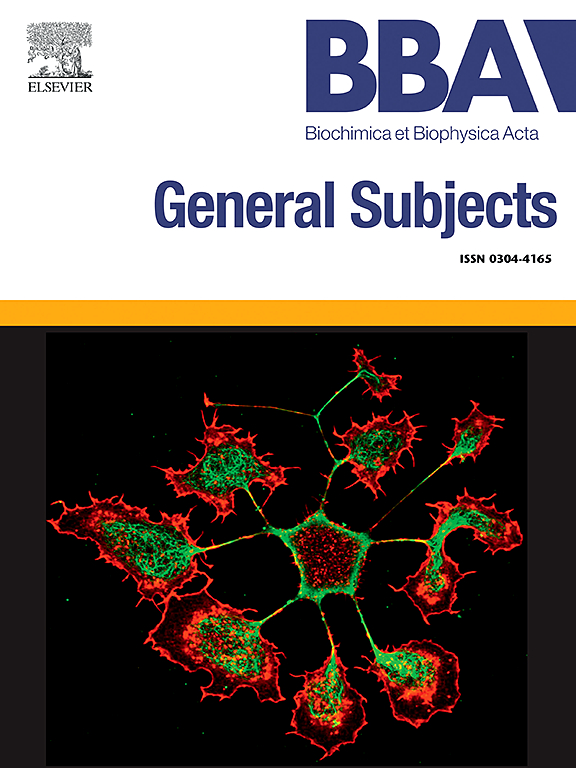Elucidating the roles of voltage sensors in NaV1.9 activation and inactivation through a spider toxin
IF 2.8
3区 生物学
Q3 BIOCHEMISTRY & MOLECULAR BIOLOGY
Biochimica et biophysica acta. General subjects
Pub Date : 2025-01-10
DOI:10.1016/j.bbagen.2025.130762
引用次数: 0
Abstract
The gating process of voltage-gated sodium (NaV) channels is extraordinary intrinsic and involves numerous factors, such as voltage-sensing domain (VSD), the N-terminus and C-terminus, and the auxiliary subunits. To date, the gating mechanism of NaV channel has not been clearly elucidated. NaV1.9 has garnered significant attention due to its slow gating kinetics. Due to the challenges of NaV1.9 heterologous expression, research on its gating mechanism is relatively limited. Whether there are any differences in the functions of the four VSDs in NaV1.9 compared to those in other subtypes remains an open question. Here, we employed the established chimera method to transplant the S3b-S4 motif from the VSDIV of the toxin-sensitive donor channel (NaV1.9) into the receptor channel (NaV1.9/1.8 DIV S3b-S4 chimera). This modification imparted animal toxin sensitivity to the other three VSDs. Our results demonstrate that all four VSDs of NaV1.9 are involved in channel opening, VSDIII and VSDIV are primarily involved in regulating fast inactivation, and VSDII also regulates the steady-state inactivation of channels. These findings provide a new insight into the gating mechanism of NaV1.9.
通过蜘蛛毒素阐明电压传感器在NaV1.9激活和失活中的作用。
电压门控钠(NaV)通道的门控过程是非常固有的,涉及许多因素,如电压感应域(VSD)、n端和c端以及辅助亚基。迄今为止,NaV通道的门控机制尚不清楚。NaV1.9由于其缓慢的门控动力学而引起了广泛的关注。由于NaV1.9异源表达的挑战,对其门控机制的研究相对有限。与其他亚型相比,NaV1.9中四种vsd的功能是否存在差异仍是一个悬而未决的问题。本研究采用已建立的嵌合体方法,将S3b-S4基序从毒素敏感供体通道(NaV1.9)的VSDIV移植到受体通道(NaV1.9/1.8 DIV S3b-S4嵌合体)中。这种修饰使其他三种VSDs对动物毒素敏感。结果表明,NaV1.9的4种vsd均参与通道开通,其中VSDIII和VSDIV主要参与通道快速失活调控,VSDII也参与通道稳态失活调控。这些发现为NaV1.9的门控机制提供了新的视角。
本文章由计算机程序翻译,如有差异,请以英文原文为准。
求助全文
约1分钟内获得全文
求助全文
来源期刊

Biochimica et biophysica acta. General subjects
生物-生化与分子生物学
CiteScore
6.40
自引率
0.00%
发文量
139
审稿时长
30 days
期刊介绍:
BBA General Subjects accepts for submission either original, hypothesis-driven studies or reviews covering subjects in biochemistry and biophysics that are considered to have general interest for a wide audience. Manuscripts with interdisciplinary approaches are especially encouraged.
 求助内容:
求助内容: 应助结果提醒方式:
应助结果提醒方式:


